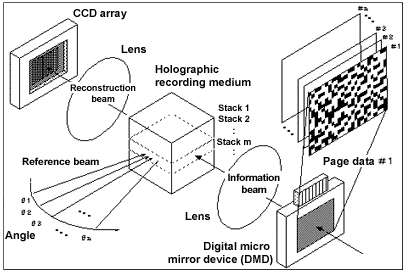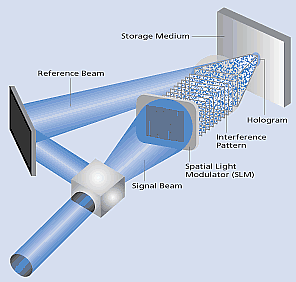
What You Must Know About Holographic Storage
The so-called fourth generation of optical storage format has been highly promoted lately, and considering that neither the Blu-Ray nor the HD DVD has become a de facto standard for HD content, Optware and Inphase Technologies offer prospects for terrabytes of storage.
Currently, there are two competitive storage technologies based on Holography: The HVD (Holographic Versatile Disc) backed by Japanese Optware, and the holographic technology introduced by US' Inphase technology, in collaboration with Bayer.
Optware's HVD
The HVD (Holographic Versatile Disc) format is currently promoted by the HVD Alliance, established last year. Founding members include CMC Magnetics (manufacturer of optical storage media), Fuji Photo Film (imaging media), Nippon Paint (paints and coating industry), Pulstec (test equipment), Toagosei (chemicals, photoresists, acrylic plastics etc) and Optware (research). Toshiba, Matsushita and Konica Minolta have also supported the HVD format.
Currently, the HVD Alliance promises capacities of up to 1.3 TB, a capacity equivalent to that provided by approximately 143 DVD-9s, and a data transfer rate of up to 1Gbps, which is almost 40 times faster than a DVD. ultimately, HVD promises capacities of 4TB.
Optware Corporation has been the main driving force behind holography. The Japanese company developed the collinear technology, used to create three-dimensional holographic images. The technology uses two separate laser diodes (sources) - one red (650nm) and one green (532nm).
The recording process begins with the green laser beam, where it is firstly split into two different optical signals. The first signal is used as a reference beam and the other, the information beam, passes through a Digital Micro Mirror (DMM). This creates the two-dimensional page data that is stored on the disc.
The two green laser beams and the third laser beam are then combined and pass through a set of objective lens, and onto the disc, as a single beam. The generated interference patterns represent the digital data.

One of the advantages of the HVD technology could interest Hollywood: By adjusting one of the green laser beams, it is possible to create a form of physical encryption on the disc, making it unplayable unless you reset the beam exactly as it was during the recording process. But this could also turn out to be a problem for the end-user. This kind of physical encryption could occur accidentally, if users do not playback the disc at the same temperature as it has been recorded. The photopolymer used on the recording media may change, leading to different data patterns. In collaboration with Optware, Sony has managed to solve this issue, by modifying the beam during playback to compensate for the change in temperature.
Inphase Holography
Inphase Technologies is a U.S. company founded by scientists from Bell Labs. The company has currently developed a working prototype which is able to hold 70GB of data on a 12cm disc, can record six times faster and playback three time faster than Blu-ray. Inphase uses what it calls the "polytonic" recording, coupled with high numerical aperture (NA). The result is a high recording density, which means that large amount of data is recorded in a small part of the recording medium, making the technology applicable on 120mm discs, and credit cards, etc.
German Bayer MaterialScience AG is cooperating with Inphase on the development of the proper raw polymer materials used for the holographic discs, dubbed Tapesty Holographic Discs.

As in the case of Optware's proposal, Tapesty uses two laser beam - a reference beam and a signal beam. In the Inphase recording device, the beam is split into two laser paths. The reference beam is guided directly on the disc, while the other passes through a spatial light modulator (SLM). The SLM creates the page array by translating the digital marks ('1s' and '0s') into light and dark pixels and creating the "checkerboard" pattern of the data page, which is finally recorded on the photosensitive recording polymer of the disc.
The basic advantage of the Tapesty system is the fact that millions of bits (data) can be recorded and read in pages by a single flash of light (laser). As a result, Tapesty outruns optical discs in terms of data transfer rates.
InPhase has announced that it will release a 300GB drive this year, and plans to deliver a 1.6TB system in three years from now.
Optware's HVD
The HVD (Holographic Versatile Disc) format is currently promoted by the HVD Alliance, established last year. Founding members include CMC Magnetics (manufacturer of optical storage media), Fuji Photo Film (imaging media), Nippon Paint (paints and coating industry), Pulstec (test equipment), Toagosei (chemicals, photoresists, acrylic plastics etc) and Optware (research). Toshiba, Matsushita and Konica Minolta have also supported the HVD format.
Currently, the HVD Alliance promises capacities of up to 1.3 TB, a capacity equivalent to that provided by approximately 143 DVD-9s, and a data transfer rate of up to 1Gbps, which is almost 40 times faster than a DVD. ultimately, HVD promises capacities of 4TB.
Optware Corporation has been the main driving force behind holography. The Japanese company developed the collinear technology, used to create three-dimensional holographic images. The technology uses two separate laser diodes (sources) - one red (650nm) and one green (532nm).
The recording process begins with the green laser beam, where it is firstly split into two different optical signals. The first signal is used as a reference beam and the other, the information beam, passes through a Digital Micro Mirror (DMM). This creates the two-dimensional page data that is stored on the disc.
The two green laser beams and the third laser beam are then combined and pass through a set of objective lens, and onto the disc, as a single beam. The generated interference patterns represent the digital data.

One of the advantages of the HVD technology could interest Hollywood: By adjusting one of the green laser beams, it is possible to create a form of physical encryption on the disc, making it unplayable unless you reset the beam exactly as it was during the recording process. But this could also turn out to be a problem for the end-user. This kind of physical encryption could occur accidentally, if users do not playback the disc at the same temperature as it has been recorded. The photopolymer used on the recording media may change, leading to different data patterns. In collaboration with Optware, Sony has managed to solve this issue, by modifying the beam during playback to compensate for the change in temperature.
Inphase Holography
Inphase Technologies is a U.S. company founded by scientists from Bell Labs. The company has currently developed a working prototype which is able to hold 70GB of data on a 12cm disc, can record six times faster and playback three time faster than Blu-ray. Inphase uses what it calls the "polytonic" recording, coupled with high numerical aperture (NA). The result is a high recording density, which means that large amount of data is recorded in a small part of the recording medium, making the technology applicable on 120mm discs, and credit cards, etc.
German Bayer MaterialScience AG is cooperating with Inphase on the development of the proper raw polymer materials used for the holographic discs, dubbed Tapesty Holographic Discs.

As in the case of Optware's proposal, Tapesty uses two laser beam - a reference beam and a signal beam. In the Inphase recording device, the beam is split into two laser paths. The reference beam is guided directly on the disc, while the other passes through a spatial light modulator (SLM). The SLM creates the page array by translating the digital marks ('1s' and '0s') into light and dark pixels and creating the "checkerboard" pattern of the data page, which is finally recorded on the photosensitive recording polymer of the disc.
The basic advantage of the Tapesty system is the fact that millions of bits (data) can be recorded and read in pages by a single flash of light (laser). As a result, Tapesty outruns optical discs in terms of data transfer rates.
InPhase has announced that it will release a 300GB drive this year, and plans to deliver a 1.6TB system in three years from now.





















